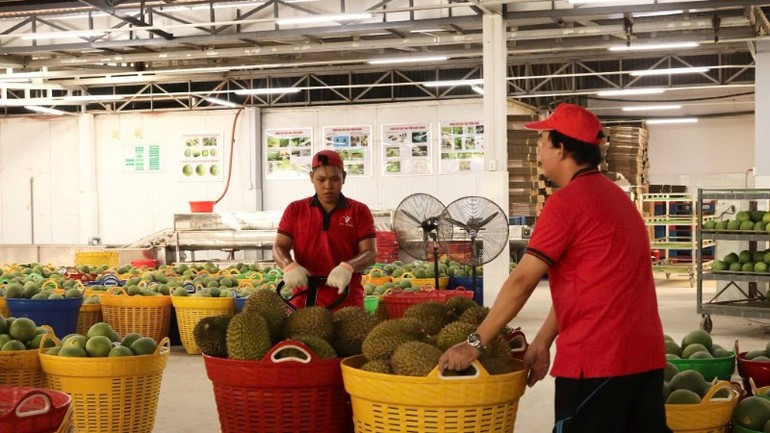Viet Nam aims to boost competitiveness of seasonal agricultural produce
Currently, many of Viet Nam’s seasonal fruits such as lychee, longan, mango, rambutan, dragon fruit, and durian are facing considerable pressure in harvesting, transportation, and consumption, easily causing congestion and price drops.

Tariff and non-tariff barriers in international markets are also increasing, posing challenges for exporters in maintaining orders and preserving market share.
Therefore, businesses must stay regularly and promptly updated on price fluctuations, trade policies, promotional programmes, trade fairs, and potential distribution channels to adjust their export plans flexibly and appropriately for each period.
Pressure of preservation and export
Ngo Thi Thu Hong, General Director of Ameii Viet Nam Joint Stock Company, said that lychee is among the most seasonal fruits in Viet Nam and currently faces significant consumption challenges due to the differing quarantine requirements of each export market. Specifically, Japan requires fresh lychee to be treated with Methyl Bromide to eliminate pests, the Republic of Korea mandates hot steam treatment, while the US demands irradiation.
At present, only one facility in Ho Chi Minh City is licensed to irradiate lychees for export to the US. As a result, after harvesting, companies must transport lychees from the north to the south for irradiation before exporting them, which leads to prolonged transit times and difficulties in preserving fresh lychees.
“In addition, Viet Nam’s logistics costs remain very high, especially in 2024–2025, which significantly affects the price competitiveness of Vietnamese companies compared to those from countries and territories with lower logistics costs such as China, Mexico, and Taiwan (China),” Hong stressed.
According to the Agency of Foreign Trade under the Ministry of Industry and Trade, the global lychee market is expected to continue growing strongly, reaching 8.79 billion USD by 2028. Key growth drivers include the development of new lychee varieties, application of advanced technologies, and logistics support from governments in producer countries. Therefore, to establish and strengthen its position in the global lychee market, Viet Nam needs to invest in product quality while improving its logistics systems.
Le Thi Hong Anh, Director of the Centre for Investment, Trade and Tourism Promotion of Son La Province, noted that Son La grows many types of seasonal fruits, with key products consumed since early this year including strawberries, plums, lemons, mangoes, bananas, and longan. However, the phenomenon of bumper harvests but falling prices persists, as large harvest volumes coincide with peak season. For instance, despite the abundant plum harvest, domestic demand remains low; meanwhile, preservation and processing capacity is limited, and export activity is still modest, resulting in significant stockpiles.
At the end of July and beginning of August, Son La will enter the longan harvest season, with an expected output of nearly 160,000 tonnes, creating major consumption pressure. The province currently lacks pre-processing and processing plants; cold storage and preservation infrastructure is also severely insufficient, so most of the produce depends on fresh consumption. Only a small portion is dried by cooperatives or small enterprises, which often cannot meet stringent export standards for quality, food safety, and packaging.

Building brands and promoting trade
Nguyen Dinh Tung, General Director of Vina T&T Group — a company with experience and reputation in exporting various agricultural products globally — shared: “To reduce pressure on the consumption of agricultural products during the peak harvest season, market access is essential. To gain market access, we must strengthen product promotion, trade promotion, and branding for potential products, so that each year when the season arrives, global consumers look forward to enjoying them.
From Vina T&T Group’s experience with longan, we’ve found that promotion is extremely important. About a month before the official harvest begins, we already receive many orders from the US market.
Vina T&T Group hopes to receive support in branding longan as a signature Vietnamese fruit. Typically, each country selects a few representative fruits to promote — for example, New Zealand has kiwifruit, the US has Washington apples, and the Republic of Korea has Shine Muscat grapes. Meanwhile, Viet Nam has a wide variety of fresh, delicious fruits, but has yet to build a strong international brand for any of them.”
According to Ta Duc Minh, Commercial Counsellor at the Viet Nam Trade Office in Japan, the office has coordinated with relevant agencies to step up export promotion activities, and to regularly and promptly provide market information for businesses to consult and explore.
For seasonal fruits such as lychee, as early as the middle of the second quarter of 2025, the Trade Office held discussions with importers on market updates and import timelines. When the first lychee shipments of the 2025 season arrived in Japan at the end of May, they were introduced during the Viet Nam Festival in Japan.
Additionally, in the first half of 2025, the trade office organised two delegations of Japanese enterprises to Viet Nam to explore the investment and business environment and to seek import sources. In the long term, the trade office is calling for and promoting Japanese investment in several fields in Viet Nam, including logistics and agro-food processing.
From the perspective of state agencies, Vũ Bá Phú, Director General of the Viet Nam Trade Promotion Agency under the Ministry of Industry and Trade, affirmed that when businesses provide specific “briefs” for trade promotion into target markets, the agency is ready to coordinate and support. Accordingly, it can assist enterprises annually with organising exhibitions and fairs within the grounds of embassies or other venues in host countries.
Regarding brand building — such as with longan from Vina T&T Group — the agency can also work with the company to register a dedicated brand for the product, and then actively support its export promotion, with the aim of ensuring the best possible development for seasonal Vietnamese agricultural products.








